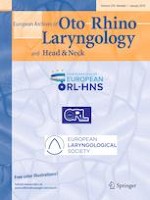Erschienen in:

01.11.2018 | Rhinology
Molecular interactions in juvenile nasopharyngeal angiofibroma: preliminary signature and relevant review
verfasst von:
Anupam Mishra, Riddhi Jaiswal, Pandey Amita, S. C. Mishra
Erschienen in:
European Archives of Oto-Rhino-Laryngology
|
Ausgabe 1/2019
Einloggen, um Zugang zu erhalten
Abstract
Background
The molecular profile of juvenile nasopharyngeal angiofibroma (JNA) is extremely variable. In absence of established molecular signature the molecular targeting seems difficult for this heterogeneous disease. To establish a basic molecular signature, this paper analyses the interaction of 7 markers according to their ranks as per the decreasing scale of molecular expression.
Materials and methods
Fourteen samples of JNA were obtained following surgical excision and mRNA expressions were established through real-time polymerase chain reaction (RT-PCR) for vasculoendothelial growth factor (VEGF), fibroblastic growth factor (FGF), c-Kit, c-myc, Ras, platelet-derived growth factor (PDGF) and tumor suppressor gene p53. Nasal polyp was taken as control. The quantitative expressions for every marker were ranked on a decreasing scale and were compared by Spearman’s rank correlation test to define the statistically significant interaction. An attempt was also made to overview the basic clinical parameters (age, duration of symptoms, radiological staging, intraoperative haemorrhage and tumor-volume/weight) associated with enhanced molecular expressions for every marker. Results: Five significant molecular interactions were identified on the basis of rank-correlation: (1) FGF/VEGF (p < 0.01); (2) Ras/FGF (p < 0.01); (3) Ras/VEGF (p < 0.001), (4) FGF/c-Kit (p < 0.05); (5) c-Myc/p53 (p < 0.05). These basic ‘molecular signatures’ suggested a preliminary ‘molecular classification’. The implication of the interactions between FGF, VEGF and Ras were the most outstanding observation that not only revealed a direct relationship but were also consistent with the clinical behaviour. In addition, a non-significant interaction was identified with c-Myc/PDGF and also an inverse relationship between FGF/c-Kit.
Conclusions
FGF, VEGF, and Ras being significantly interrelated seemed to be the ‘most soft’ molecular targets for JNA. The other targets observed included FGF/c-Kit and c-Myc/p53 interactions that seemed equally important but only after VEGF/FGF/Ras complex per se. These preliminary signatures are likely to provide a background for further expansion of the molecular classification of JNA.